2016 MERCEDES-BENZ GL ECU
[x] Cancel search: ECUPage 267 of 462
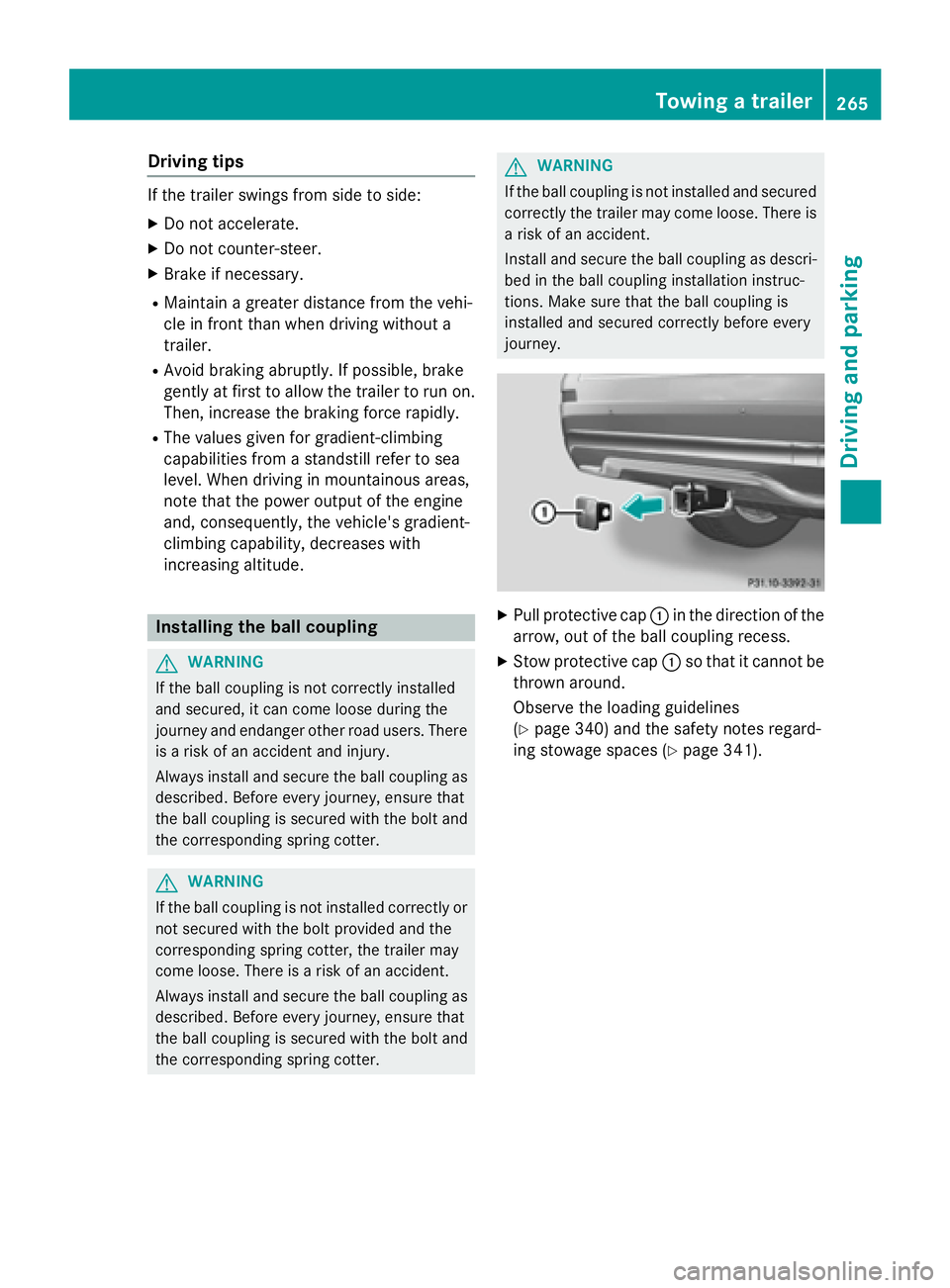
Drivin g tipsIf th e trailer swings from sid e to side:X
Do no t accelerate.X
Do no t counter-steer .X
Brak e if necessary.R
Maintain a greater distanc e from th e vehi-
cl e in fron t than when drivin g without a
trailer .R
Avoid braking abruptly. If possible, brake
gentl y at first to allow th e trailer to run on .
Then, increase th e braking forc e rapidly.R
The values given fo r gradient-climbin g
capabilities from a standstill refer to sea
level. Whe n drivin g in mountainous areas,
note that th e powe r output of th e engin e
and , consequently, th e vehicle' s gradient-
climbin g capability, decreases wit h
increasing altitude.
Installing th e ball coupling
G WARNING
If th e ball couplin g is no t correctl y installed
and secured, it can come loose durin g th e
journey and endanger other road users. There
is a ris k of an acciden t and injury.
Always install and secure th e ball couplin g as
described . Before every journey, ensur e that
th e ball couplin g is secure d wit h th e bolt and
th e correspondin g sprin g cotter.
G WARNING
If th e ball couplin g is no t installed correctl y or
no t secure d wit h th e bolt provided and th e
correspondin g sprin g cotter, th e trailer may
come loose. There is a ris k of an accident.
Always install and secure th e ball couplin g as
described . Before every journey, ensur e that
th e ball couplin g is secure d wit h th e bolt and
th e correspondin g sprin g cotter. G WARNING
If th e ball couplin g is no t installed and secure d
correctl y th e trailer may come loose. There is
a ris k of an accident.
Install and secure th e ball couplin g as descri-
bed in th e ball couplin g installation instruc -
tions. Mak e sur e that th e ball couplin g is
installed and secure d correctl y befor e every
journey.
X
Pull protective cap �C in th e direction of th e
arrow, out of th e ball couplin g recess .X
Stow protective cap �C so that it canno t be
thrown around .
Observ e th e loadin g guidelines
( Y
page 340) and th e safet y note s regard -
in g stowag e spaces ( Y
page 341).Towing a trailer 265
Driving and parking Z
Page 270 of 462
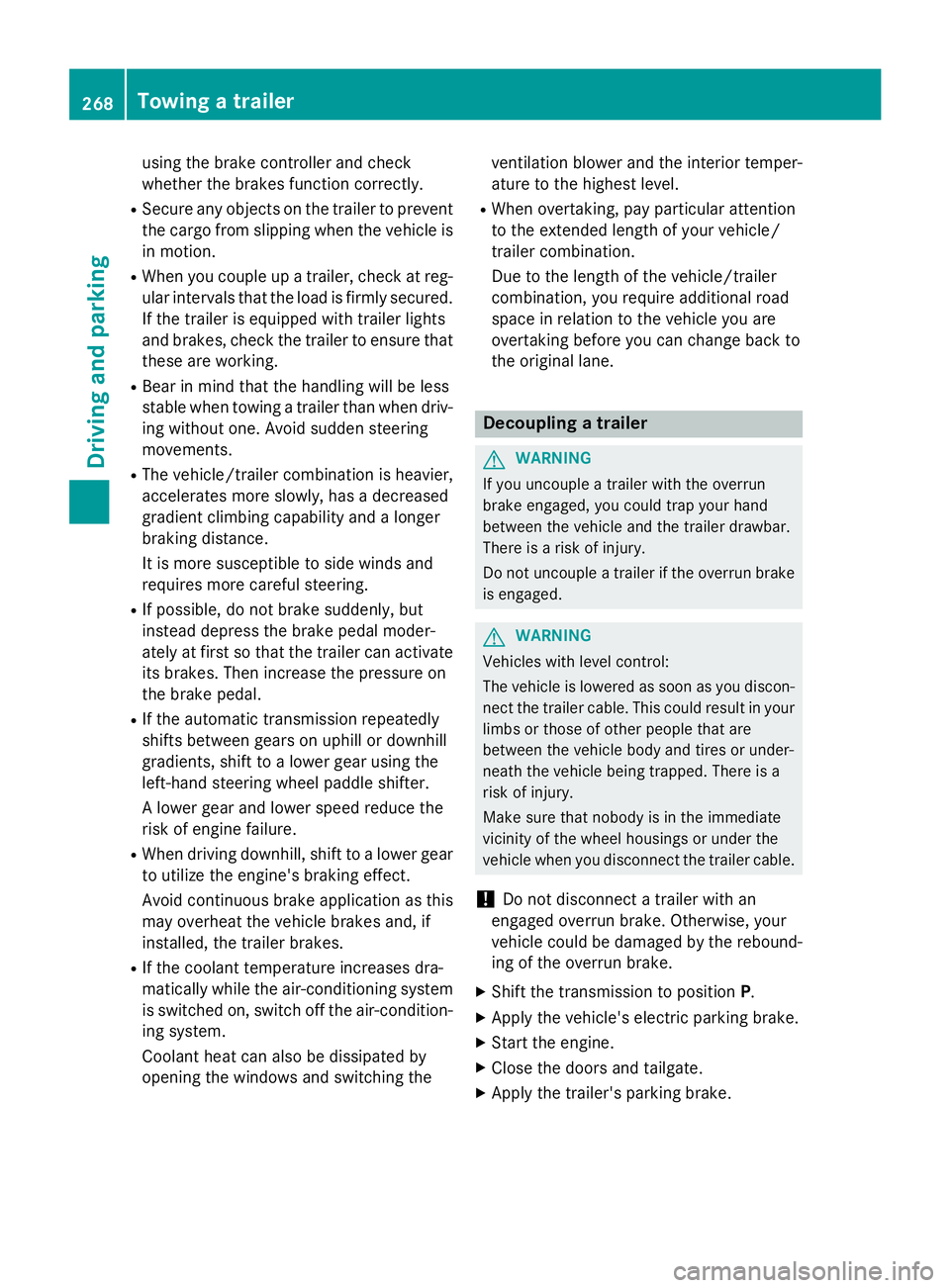
using the brake controller and check
whether the brakes function correctly. R
Se cure any objects on the trailer to prevent
the cargo from slipping when the vehicle is
in motion. R
When you couple up a trailer, check at reg-
ular intervals that the load is firmly secured.
If the trailer is equipped with trailer lights
and brakes, check the trailer to ensure that
these are working. R
Bear in mind that the han dlin g will be less
st able when towing a trailer than when driv-
ing wit hout one. Avoid sudden steering
movements. R
The vehicle/trailer combination is heavier,
accelerates more slowly, has a decreased
gradient cli mbin g capability and a longer
braking dist ance.
It is more susceptible to side winds and
requires more careful steering. R
If poss ible, do not brake suddenly, but
instead depr ess the brake pedal moder-
ate ly at first so that the trailer can activate
it s brakes. Then increase the pressure on
the brake pedal. R
If the automat ic transmission repeat edly
shifts between gears on uphill or down hill
gradients, shift to a lower gear using the
left-hand steering wheel paddle shifter.
A lower gear and lower speed reduce the
risk of engine failure. R
When driv ing down hill, shift to a lower gear
to uti liz e the engine's braking effect.
Avoid continuous brake application as this
m ay
overheat the vehicle brakes and, if
instal led, the trailer brakes.R
If the coolant temperature increases dra-
matical ly while the air-cond it ioning system
is swit ched on, switch off the air-condition-
ing system.
Coolant heat can also be dissipated by
opening the win dows and switching the ventilation blowe r and the interior temper-
ature to the highest leve l.R
When overtaking, pay particular attention
to the extended length of your vehicle/
trailer combination.
Due to the length of the vehicle/trailer
combination, you require additional road
space in relation to the vehicle you are
overtaking before you can change back to
the original lane.
Decoupling a trailer
G WARNIN G
If you uncouple a trailer wit h th e overrun
brak e engaged , you could trap your han d
between th e vehicl e and th e trailer drawbar.
Ther e is a ris k of injury.
Do no t uncouple a trailer if th e overrun brak e
is engaged .
G WARNIN G
Vehicles wit h leve l control :
The vehicl e is lowered as soo n as you discon -
nect th e trailer cable. This could result in your
limb s or those of other people that are
between th e vehicl e body and tires or under-
neath th e vehicl e bein g trapped . Ther e is a
ris k of injury.
Mak e sure that nobody is in th e immediat e
vicinity of th e whee l housing s or under th e
vehicl e when you disconnect th e trailer cable.
! Do not disc onnect a trailer wit h an
engaged overrun brake. Otherwise, your
vehicle could be damaged by the reboun d-
ing of the overrun brake. X
Sh ift the transmission to position P .X
Ap ply the vehicle's electr ic parking brake.X
St art the engine. X
Close the doors and tailgate. X
Apply the trailer's parking brake.268
Towing a trailer
Driving and parking
Page 297 of 462
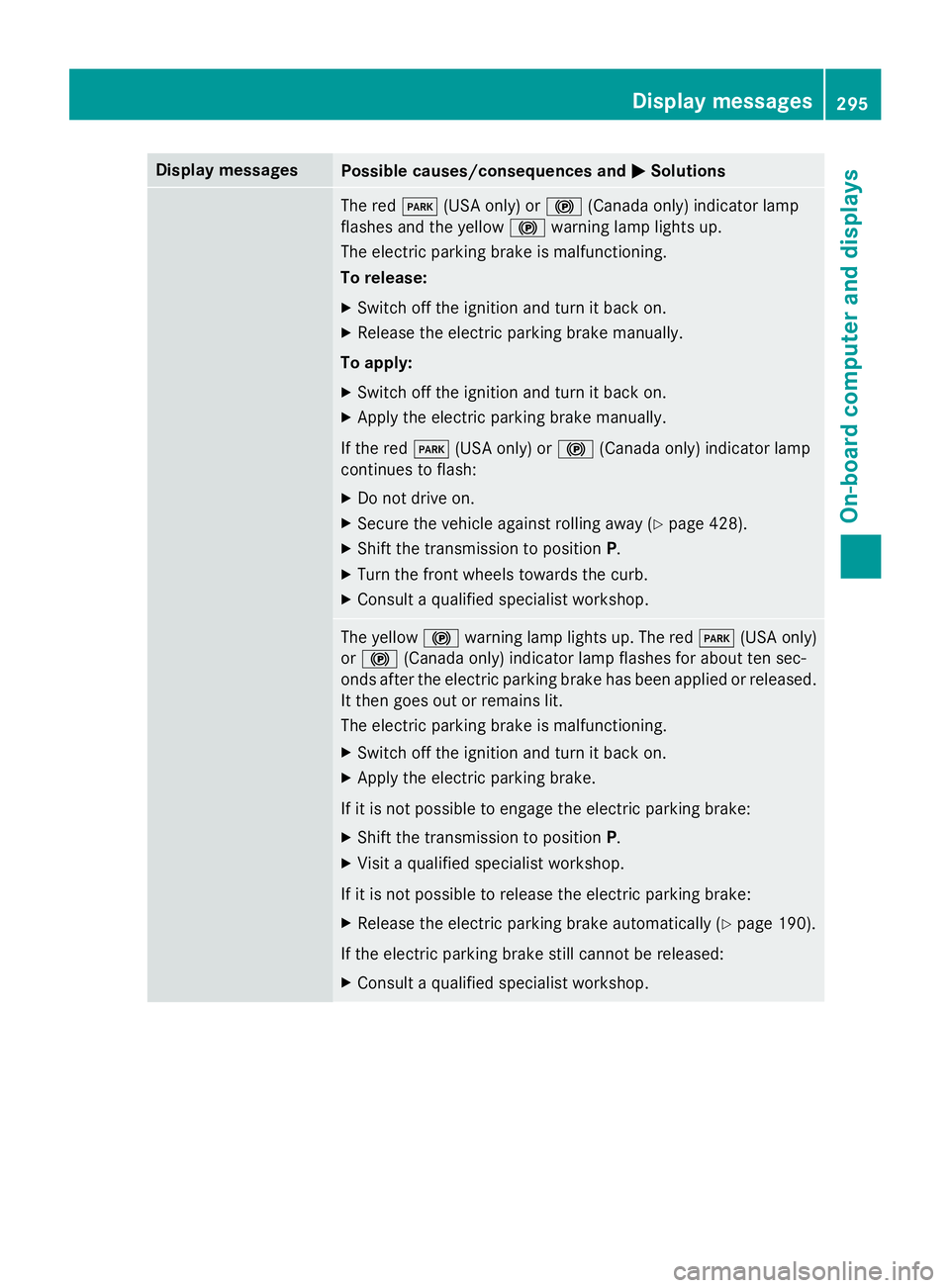
Display messages
Possible causes/consequences and �P Solutions
The red �I (US A only) or �$ (Canada only) indicato r lamp
flashes and th e yello w �$ warnin g lamp lights up.
The electric parkin g brak e is malfunctioning.
To release: X
Switc h of f th e ignition and tur n it bac k on .X
Releas e th e electric parkin g brak e manually.
To apply: X
Switc h of f th e ignition and tur n it bac k on .X
Apply th e electric parkin g brak e manually.
If th e red �I (US A only) or �$ (Canada only) indicato r lamp
continues to flash: X
Do no t drive on .X
Secur e th e vehicl e against rollin g away ( Y
page 428).X
Shift th e transmissio n to position P .X
Tur n th e fron t wheels toward s th e curb.X
Consult a qualified specialist workshop .
The yello w �$ warnin g lamp lights up. The red �I (US A only)
or �$ (Canada only) indicato r lamp flashes fo r about te n sec -
onds after th e electric parkin g brak e has been applied or released.
It then goe s out or remain s lit .
The electric parkin g brak e is malfunctioning.X
Switc h of f th e ignition and tur n it bac k on .X
Apply th e electric parkin g brake.
If it is no t possibl e to engage th e electric parkin g brake:X
Shift th e transmissio n to position P .X
Visit a qualified specialist workshop .
If it is no t possibl e to release th e electric parkin g brake:X
Releas e th e electric parkin g brak e automatically ( Y
page 190).
If th e electric parkin g brak e still canno t be released:X
Consult a qualified specialist workshop .Display messages 29 5
On-board computer and displays Z
Page 299 of 462
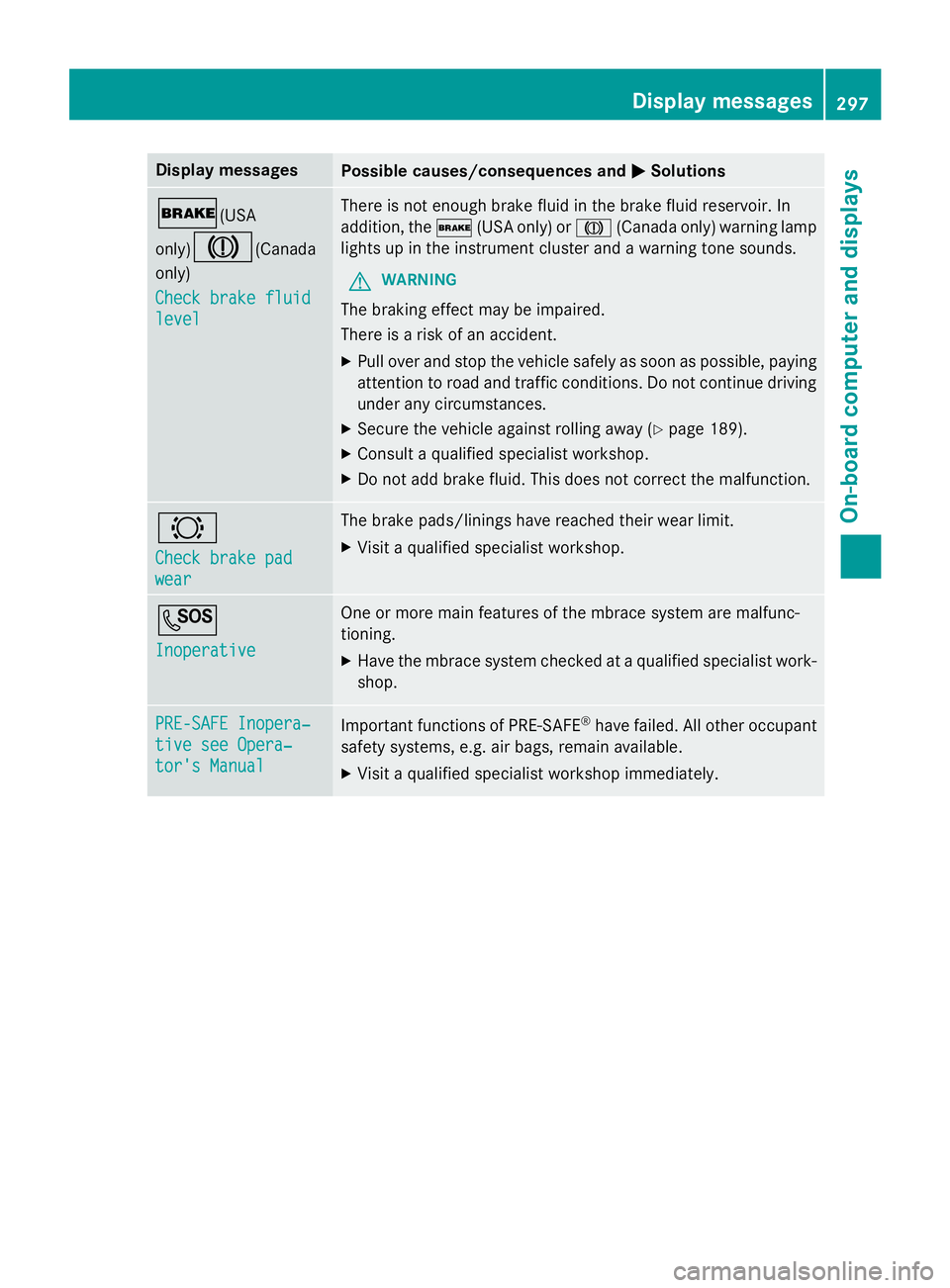
Display messages
Possible causes/consequences and �P Solutions
�' (USA
only)
�M (Canada
only)
Check brake fluid
level There is no t enough brak e flui d in th e brak e flui d reservoir . In
addition , th e �' (US A only) or �M (Canada only) warnin g lamp
lights up in th e instrumen t cluster and a warnin g tone sounds.
G WARNIN G
The brakin g effec t may be impaired.
There is a ris k of an accident. X
Pull ove r and stop th e vehicl e safely as soo n as possible, payin g
attention to roa d and traffic conditions. Do no t continue drivin g
under any circumstances. X
Secur e th e vehicl e against rollin g away ( Y
page 189).X
Consult a qualified specialist workshop .X
Do no t add brak e fluid. This does no t correc t th e malfunction .
�& Check brake pad
wea r The brak e pads/lining s hav e reached their wear limit.X
Visit a qualified specialist workshop .
�S Inoperative On e or mor e main features of th e mbrace system are malfunc -
tioning. X
Hav e th e mbrace system checke d at a qualified specialist work-
shop.
PRE-SAFE Inopera‐
tiv e see Opera‐
tor's Manual Importan t function s of PRE-SAF E ®
hav e failed. Al l other occupant
safet y systems , e.g. air bags , remain available.X
Visit a qualified specialist workshop immediately. Display messages 29 7
On-board computer and displays Z
Page 300 of 462
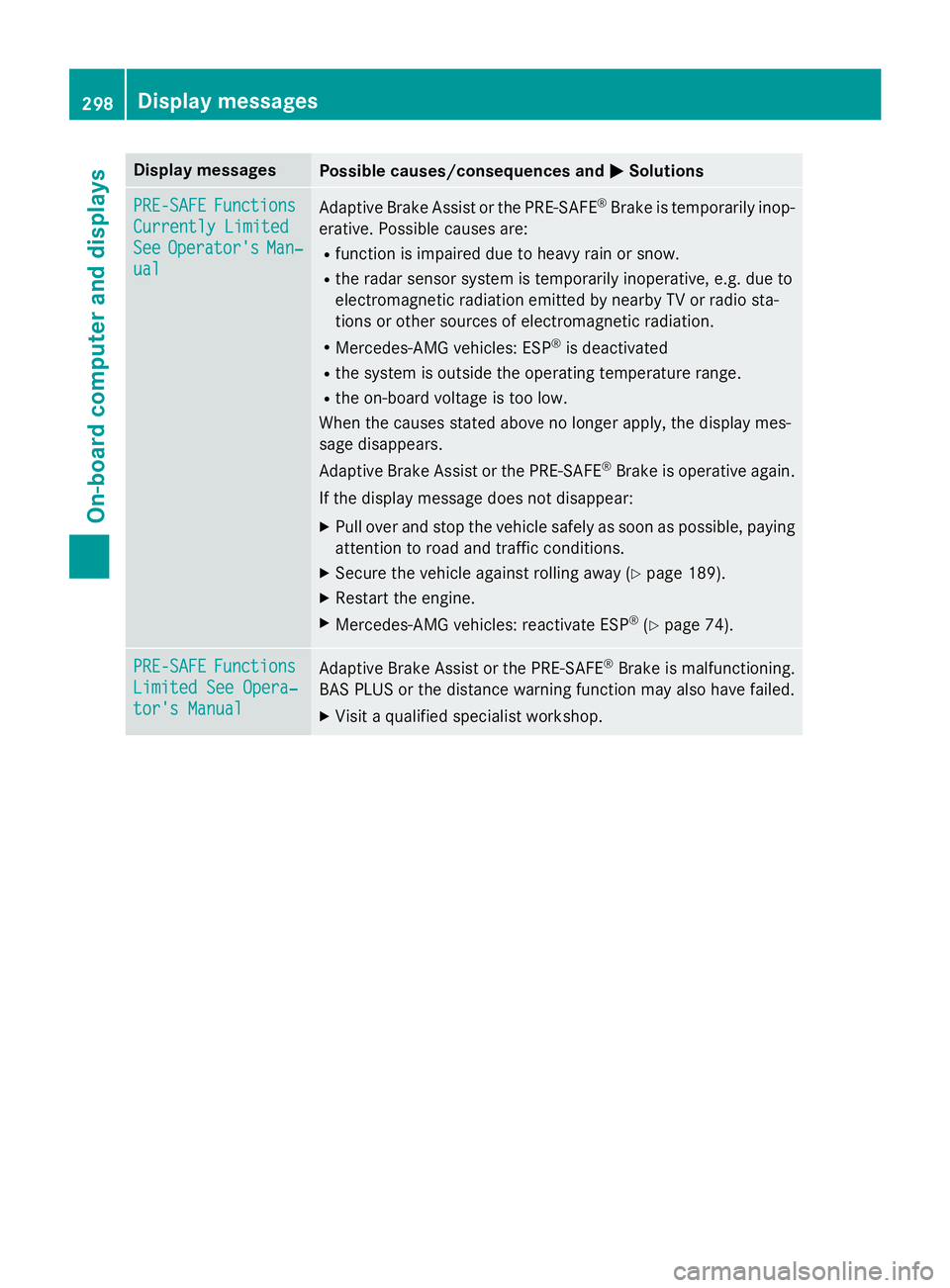
Display messages
Possible causes/consequences and �P Solutions
PRE-SAFE Functions
Currently Limite d
See Operator' s Man ‐
ual Adaptive Brake Assis t or th e PRE-SAF E ®
Brake is temporarily inop-
erative . Possibl e causes are:R
function is impaire d due to heav y rain or snow.R
th e rada r sensor system is temporarily inoperative, e.g. due to
electromagnetic radiation emitted by nearby TV or radi o sta-
tion s or other source s of electromagnetic radiation .R
Mercedes-AMG vehicles: ES P ®
is deactivatedR
th e system is outside th e operating temperature range.R
th e on-boar d voltag e is to o low.
Whe n th e causes state d abov e no longer apply, th e display mes -
sage disappears.
Adaptive Brake Assis t or th e PRE-SAF E ®
Brake is operative again .
If th e display message does no t disappear :X
Pull ove r and stop th e vehicl e safely as soo n as possible, payin g
attention to roa d and traffic conditions.X
Secur e th e vehicl e against rollin g away ( Y
page 189).X
Restart th e engine. X
Mercedes-AMG vehicles: reactivat e ES P ®
( Y
page 74).
PRE-SAFE Functions
Limite d See Opera‐
tor's Manual Adaptive Brake Assis t or th e PRE-SAF E ®
Brake is malfunctioning.
BA S PLU S or th e distanc e warnin g function may also hav e failed.X
Visit a qualified specialist workshop .298
Display messages
On-board computer and displays
Page 301 of 462

Display messages
Possible causes/consequences and �P Solutions
Radar Sensor s
Dirty See Opera‐
tor's Manual At leas t on e of th e following drivin g systems or drivin g safet y sys-
tems is temporarily restricted or inoperative: R
PRE-SAF E ®
Brake R
Active Lan e Keepin g Assis tR
Active Blind Spot Assis t
If th e rada r sensor system in fron t is dirty, Active Blind Spot Assis t
will no t perform a course-correcting brak e application .
Possibl e causes are: R
th e sensor s in th e radiato r trim and/o r in th e bumpers are dirtyR
th e function of th e drivin g system and/o r drivin g safet y system
is impaire d due to heav y rain or snow.
A warnin g tone also sounds.
Whe n th e causes state d abov e no longer apply, th e display mes -
sage disappears. Al l drivin g systems and drivin g safet y systems
are operative again .
If th e display message does no t disappear :X
Pull ove r and stop th e vehicl e safely as soo n as possible, payin g
attention to roa d and traffic conditions.X
Secur e th e vehicl e against rollin g away ( Y
page 189).X
Switc h of f th e engine.X
Clean th e sensor s in th e following location s ( Y
page 380):R
in th e radiato r trim R
in th e fron t bumper R
in th e rear bumper, particularl y in th e middle of th e rear
bumper X
Restart th e engine.
The display message disappears.
�u Restraint sys . mal ‐
function Consul t
workshop The restrain t system is faulty.
The �u warnin g lamp also lights up in th e instrumen t cluster.
G WARNIN G
The air bags or Emergency Tensioning Devices may either be trig-
gered unintentionally or, in th e event of an accident, may no t be
triggered .
There is an increase d ris k of injury.X
Visit a qualified specialist workshop .
Observ e th e additional information on restrain t systems
( Y
page 44) . Display messages 29 9
On-board computer and displays Z
Page 303 of 462

Display messages
Possible causes/consequences and �P Solutions
Front Passenger
Airbag Disabled
See Operator' s Man ‐
ual
See Operator' s Man ‐
ual The front-passenger air bag is deactivated during th e journey, eve n
though : R
an adult
or R
a person of th e correspondin g stature is on th e front-passenger
seat
If additional forces are applied to th e seat , th e system may inter-
pre t th e occupant's weight as lowe r than it actually is.
G WARNIN G
The front-passenger air bag does no t deploy during an accident.
There is an increase d ris k of injury.X
Pull ove r and stop th e vehicl e safely as soo n as possible, payin g
attention to roa d and traffic conditions.X
Secur e th e vehicl e against rollin g away ( Y
page 189).X
Switc h th e ignition off. X
Hav e th e occupant get out of th e vehicle.X
Kee p th e seat unoccupied , close th e front-passenger doo r and
switch on th e ignition .X
Observ e th e PASSENGER AI R BA G OF F indicato r lamp in th e
center console and th e multifunction display and chec k th e fol-
lowing:
Seat unoccupied and ignition switched on :R
th e PASSENGER AI R BA G OF F indicato r lamp mus t then ligh t up
and remain lit . If th e indicato r lamp is on , OCS has disabled th e
front-passenger fron t air bag ( Y
page 54)R
th e Front Passenger Airbag Disabled See Operator' s
Manual or Front Passenger Airbag Disabled See Oper‐
ator's Manual display message s mus t no t be shown in th e
multifunction display X
Wait fo r a period of at leas t 60 seconds until th e necessar y sys-
te m checks hav e been completed.X
Mak e sur e that th e display message s do no t appea r in th e mul-
tifunction display.
If these condition s are fulfilled , th e front-passenger seat can be
occupied again . Whether th e PASSENGER AI R BA G OF F indicato r
lamp remain s lit or goe s out depend s on how OCS classifie s th e
occupant .
If th e condition s are no t fulfilled , th e system is no t operating cor-
rectly. X
Visit a qualified specialist workshop immediately. Display messages 30 1
On-board computer and displays Z
Page 304 of 462
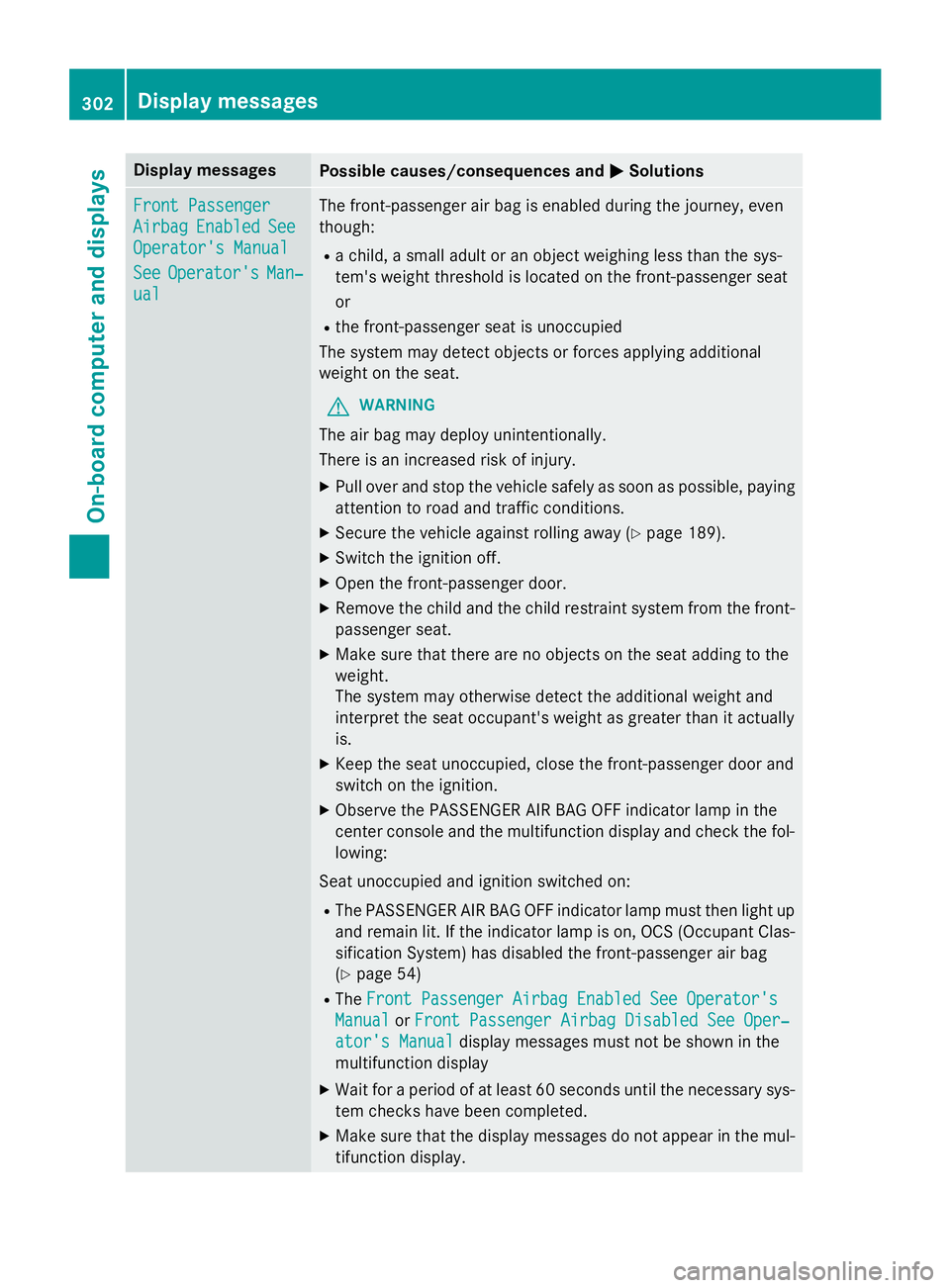
Display messages
Possible causes/consequences and �P Solutions
Front Passenger
Airbag Enable d See
Operator' s Manual
See Operator' s Man ‐
ual The front-passenger air bag is enabled during th e journey, eve n
though : R
a child, a small adult or an objec t weighin g less than th e sys-
tem' s weight threshold is locate d on th e front-passenger seat
or R
th e front-passenger seat is unoccupied
The system may detec t objects or forces applying additional
weight on th e seat .
G WARNIN G
The air bag may deploy unintentionally.
There is an increase d ris k of injury.X
Pull ove r and stop th e vehicl e safely as soo n as possible, payin g
attention to roa d and traffic conditions.X
Secur e th e vehicl e against rollin g away ( Y
page 189).X
Switc h th e ignition off. X
Ope n th e front-passenger door. X
Remove th e child and th e child restrain t system from th e front-
passenger seat .X
Mak e sur e that there are no objects on th e seat addin g to th e
weight .
The system may otherwise detec t th e additional weight and
interpret th e seat occupant's weight as greate r than it actually
is. X
Kee p th e seat unoccupied , close th e front-passenger doo r and
switch on th e ignition .X
Observ e th e PASSENGER AI R BA G OF F indicato r lamp in th e
center console and th e multifunction display and chec k th e fol-
lowing:
Seat unoccupied and ignition switched on :R
The PASSENGER AI R BA G OF F indicato r lamp mus t then ligh t up
and remain lit . If th e indicato r lamp is on , OCS (Occupant Clas-
sification System) has disabled th e front-passenger air bag
( Y
page 54) R
The Front Passenger Airbag Enable d See Operator' s
Manual or Front Passenger Airbag Disabled See Oper‐
ator's Manual display message s mus t no t be shown in th e
multifunction display X
Wait fo r a period of at leas t 60 seconds until th e necessar y sys-
te m checks hav e been completed.X
Mak e sur e that th e display message s do no t appea r in th e mul-
tifunction display.302
Display messages
On-board computer and displays